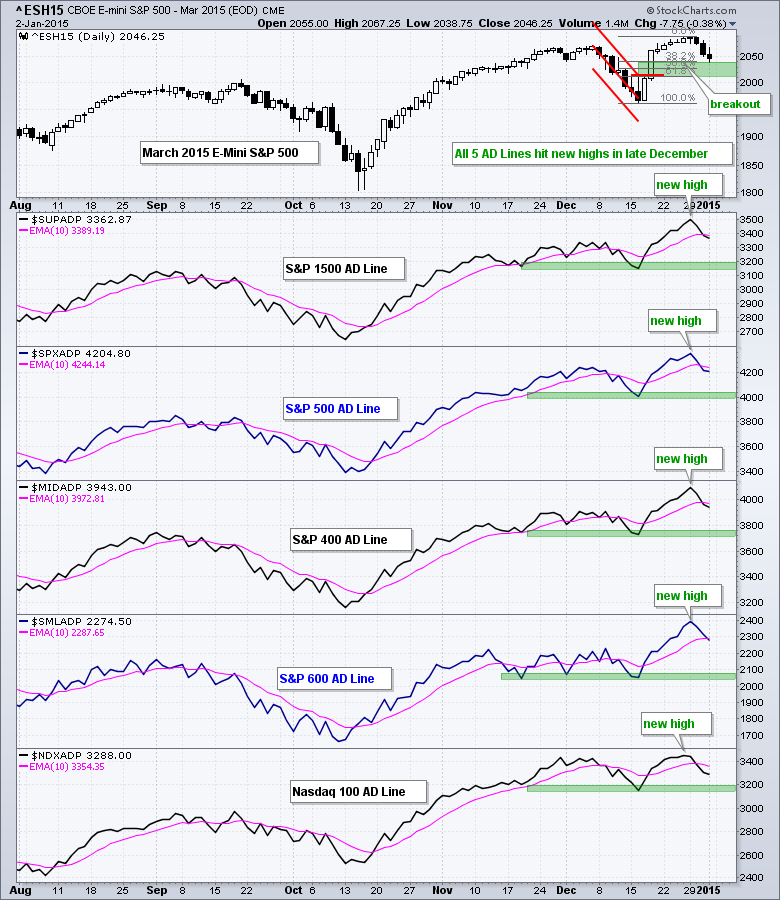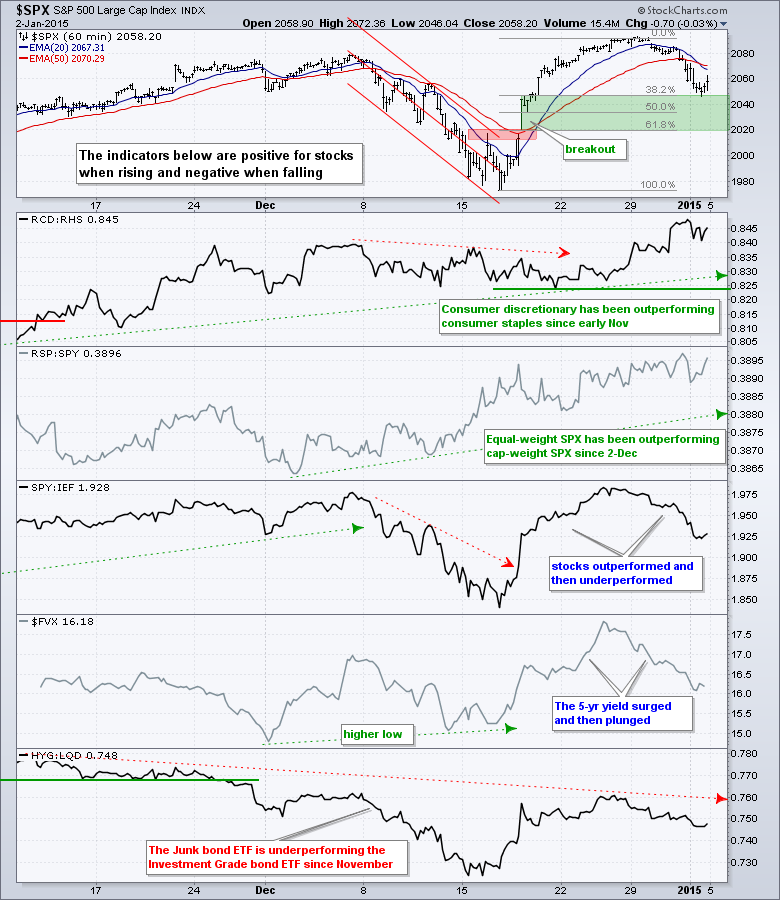Stocks got the Santa Claus rally, but it fizzled after Christmas and selling pressure took hold over the last three trading days. After a big advance from 17 to 29 December, the stock market was entitled to a pullback. The major index ETFs are now trading in big support zones for the first test of this pullback.
**This chart analysis is for educational purposes only, and should not
be construed as a recommendation to buy, sell or sell-short said securities**
Short-term Overview (Monday, 5-January-2015):
- The AD Lines pulled back, but remain bullish overall.
- The risk indicators are mixed because the bond-related indicators turned down.
- SPY broke out with a gap-surge on 18-Dec and is testing the top of its support zone.
- QQQ shows relative weakness and fell back to the middle of its support zone.
- IWM broke out with a surge on 17-Dec and is testing the top of its support zone.
- TLT broke out in late December and hit a new high.
- UUP surged to new highs as the Euro plunged to new lows.
- USO broke descending triangle support to signal a continuation lower.
- GLD turned volatile over the last few weeks, but the channel break remains the dominant chart feature.
The March E-mini S&P 500 (^ESH15) hit a new high at yearend and then fell back over the last three days. The green area marks the 38-62% retracement zone, which should hold during a normal pullback. A move below 2000 would be deemed excessive for a pullback.
The five AD Lines pulled back over the last few days and broke below their 10-day EMAs. At this point, I consider it a small pullback within a short-term uptrend. Note that all five AD Lines hit new highs in late December and these breadth indicators were entitled to a rest.
The risk indicators are mixed. The two stock-related indicators remain positive, but the three bond-related indicators fell back over the last two weeks. The consumer discretionary sector has been outperforming the consumer staples sector since early November and the equal-weight S&P 500 has been outperforming the cap-weight S&P 500 since early December. Stocks were outperforming bonds, but the SPY:IEF ratio took a hit the last two weeks. Also note that short-term Treasuries rose as the 5-year Treasury Yield ($FVX) fell sharply. Money appears to be seeking safety. Perhaps the Greek elections and European situation are pushing money into US Treasuries. Whatever the case, I think the risk indicators are mixed right now.
SPY surged around 6%, hit a new high in late December and then fell back over the last few days. Even though it is hard to give up 4 points (209 to 205), I consider this a normal pullback within an uptrend. The green zone marks the 38-62% retracement zone and the first area to watch for a bounce. A move below 201 would exceed the 62% retracement, negate the mid December breakout and call for a reassessment.
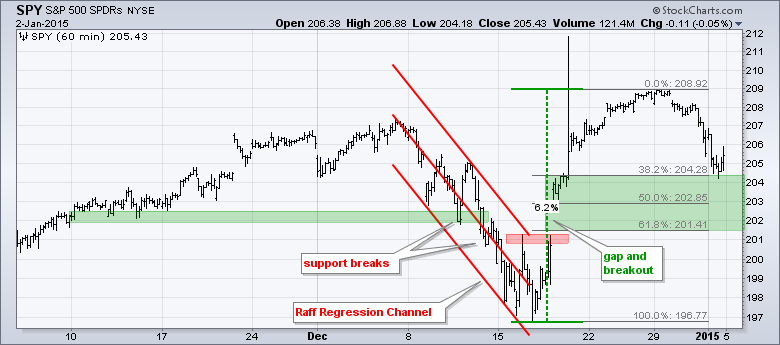
**************************************************************
QQQ is lagging because it did not exceed its late November high (whereas SPY and IWM did). Apple is also lagging with a lower high and a support break last Wednesday. On the price chart, QQQ retraced around 50% of the mid December surge and fell back into the gap zone. This is the first test for QQQ. Failure to bounce and a break below 101.5 could project a break below the mid December low.
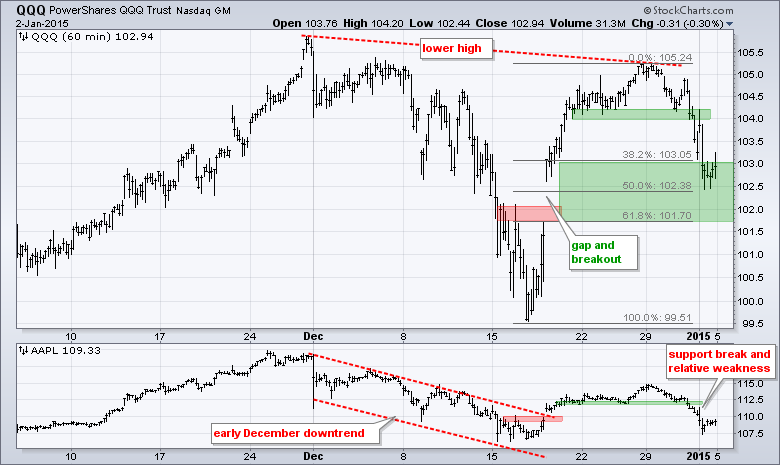
**************************************************************
IWM was the first to break out in mid December and continued on to a new high in late December. The ETF fell back with the rest of the market and hit the top of its support zone. Broken resistance and the 38% retracement mark first support in the 117.5-118 area. I will leave key support at 116 for now. Overall, IWM continues to show relative strength since early December.
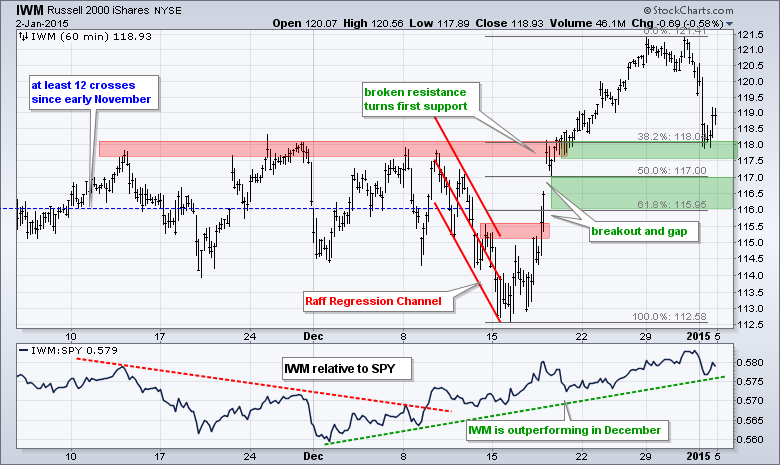
**************************************************************
The 20+ YR T-Bond ETF (TLT) surged off support in the 123 area and broke resistance to end the short correction. The resilience of the long bond is amazing. With another new high, TLT has affirmed the uptrend and I will mark first support in the 125.5 area. The late December low marks key support in the 123 area. The indicator window shows the 10-YR Treasury Yield ($TNX) breaking down.
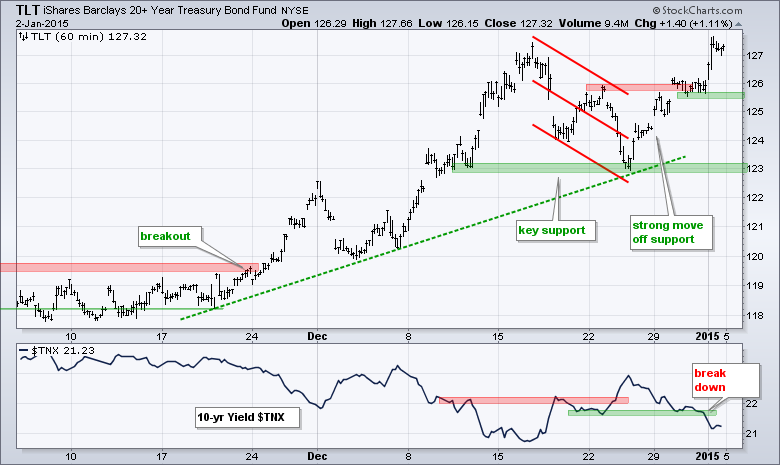
**************************************************************
The US Dollar ETF (UUP) surged to new highs at yearend and again on Friday. This move was facilitated by a sharp decline in the Euro Index ($XEU). This trade is very lopsided with lots of Dollar bulls, but it is still working and price action remains bullish for the greenback. The late December lows mark first support in the 23.8 area and I will leave key support in the 23.2-23.3 area for now.
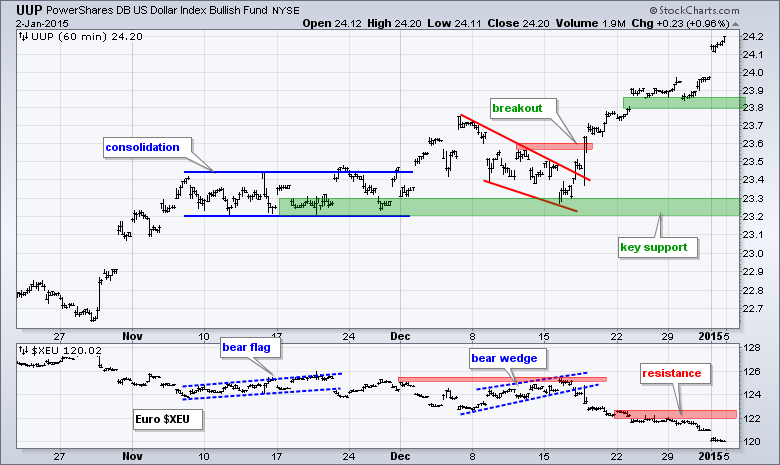
**************************************************************
The USO Oil Fund (USO) tried to firm, but the bounces were weak and a descending triangle formed. The ETF broke support with a decline to the 20 area and this signals yet another continuation lower. The late December highs mark first resistance in the 22 area.
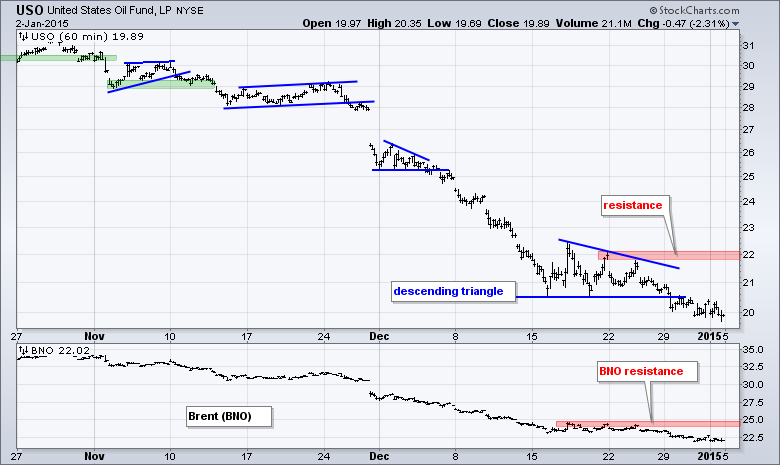
**************************************************************
The Gold SPDR (GLD) broke down in mid December and then turned quite volatile the last few weeks. Notice how GLD bounced above/below the 114.5 level at least ten times since 16-Dec. The long-term trend is down and I still view the channel break as bearish. A close above 116 is needed to negate this channel break and call for a reassessment.
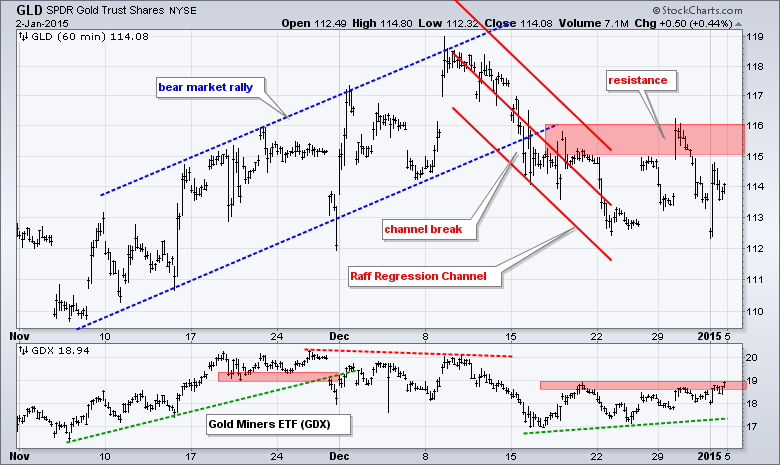
***************************************************************
Key Reports and Events (all times Eastern):
Mon - Jan 05 - 14:00 - Auto Sales/Truck Sales
Tue - Jan 06 - 10:00 - Factory Orders
Tue - Jan 06 - 10:00 - ISM Services
Wed - Jan 07 - 07:00 - MBA Mortgage Index
Wed - Jan 07 - 08:15 - ADP Employment Change
Wed - Jan 07 - 08:30 - Trade Balance
Wed - Jan 07 - 10:30 - Oil Inventories
Wed - Jan 07 - 14:00 - FOMC Minutes
Thu - Jan 08 - 07:30 - Challenger Job
Thu - Jan 08 - 08:30 - Initial Jobless Claims
Thu - Jan 08 - 10:30 - Natural Gas Inventories
Thu - Jan 08 - 14:00 - Consumer Credit
Fri - Jan 09 - 08:30 - Nonfarm Payrolls
Fri - Jan 09 - 10:00 - Wholesale Inventories
This commentary is designed to stimulate thinking. This analysis is not a recommendation to buy, sell, hold or sell short any security (stock ETF or otherwise). We all need to think for ourselves when it comes to trading our own accounts. First, it is the only way to really learn. Second, we are the only ones responsible for our decisions. Think of these charts as food for further analysis. Before making a trade, it is important to have a plan. Plan the trade and trade the plan. Among other things, this includes setting a trigger level, a target area and a stop-loss level. It is also important to plan for three possible price movements: advance, decline or sideways. Have a plan for all three scenarios BEFORE making the trade. Consider possible holding times. And finally, look at overall market conditions and sector/industry performance.

